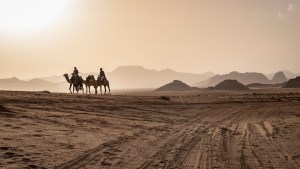The Jordan Trail is an almost 700-kilometer-long hiking trail that connects Jordan, from north to south —the Holy Land-based equivalent of, let’s say, a Camino de Santiago. It begins in Umm Qais, by the ruins of Gadara, the ancient Roman and Greek town overseeing Lake Tiberias (the Sea of Galilee). According to the Synoptic Gospels, this is where Jesus exorcised the Gadarene demoniac —a passage popularly known as “the miracle of the Gadarene swine,” or “the exorcism of Legion.”
Founded as a military colony by Alexander’s Macedonian Greeks on the remains of a pre-existing military colony, Gadara preserves its original Roman streets and amphitheater, and the remains of an ancient Byzantine church. The local museum of Beit Rousan houses an impressive collection of Hellenistic (including Christian) and Islamic art.
This exceptional meeting of pre-Christian, Macedonian, Greek, Roman, and Islamic cultures, traditions, and treasures, repeats itself over and over through the Trail. Pilgrims can choose whether to cover the eight different regions (a trip that would last at least 40 days, in a typically biblical way), or the region (or regions) of their preference: from Umm Qais to Ajloun, from Ajloun to Salt, from Salt to Wadi Zarqa Ma’in (including the Roman Road and the canyons of the Dead Sea), from Wadi Zarqa Ma’in to Karak (the Crusaders’ Castle), from Karak to Dana (an exceptionally green biosphere reserve), from Dana to the legendary Petra, from Petra to the impressive sands of the Wadi Rum desert, and from the desert, finally, to the Red Sea.

Pilgrims can also join an already existing group of pilgrims or not, and get their JTPass: an official trail passport, hiking log, and achievement recorder that can also be presented when needed to authorities —not to mention a unique keepsake too. Of course, there’s a six-day route anyone can walk (in fact, this is the most popular one), which covers the ancient Nabatean city of Petra, through some of the Jordanian sandstone ridges. As one walks it, Roman, Nabatean, Byzantine and Ummayad buildings, traditions and stories are found living alongside each other, in a journey uniting the Old and the New Testament in a single route.
Covering around 75 villages and towns on its (full) way (not to mention all sorts of archaeological treasures, holy places, byzantine remains, pilgrim houses, ancient eremitic caves, basilicas, and Nabatean cities) the Trail also offers the visitor the opportunity to appreciate the diverse landscape of the country, from the green hills of the north, through the wadis and cliffs around the Jordan Rift Valley (and its famous thermal waters), through the impressive sandy rosy rocks of Petra and the breathtaking sands and starry skies of the Wadi Rum, all the way to the transparent waters of the Red Sea and its rich coral reefs —one of the main reasons why tourists go in flocks to stay in the numerous beach resorts in Aqaba.
Clearly, walking the Trail means discovering the history of Jordan, enjoying its diverse culture, its legendary biblical hospitality, and tasting its cuisine. But it is also a spiritual journey. Biblical tradition maintains that Moses walked across Jordan, from the Red Sea in the south all the way to the north, to Mount Nebo. In fact, the closest city to the ancient Nabatean city of Petra is called “Wadi Mousa,” “the Valley of Moses,” very close to what tradition has also identified as Moses’ well —where Moses struck water from the rock. This ancient path also goes by the birthplace of Prophet Elijah, where pilgrims from all Abrahamic religions pay homage to the prophet who also walked this very same road, all the way to Mount Carmel. Following the steps of Moses and Elijah eventually takes the pilgrim to the way to the river Jordan, and the baptismal site of Jesus Christ.

The Jordan Trail is far from being new. It has been there for far more than 20 centuries, surrounded by tall cliffs where one can still see the caves hermits used to live in, olive trees, creeks, and Nabatean, Moabite, Edomite, Roman, Greek, and Neolithic ruins alike. Officially (re)launched in April 2017 by the Jordan Tourism Board, the trail follows both ancient biblical routes and the paths Roman conquerors would use to go all the way from the fertile north of Jordan (Amman was then called “Philadelphia,” and was one of the ten cities of Hadrian’s Decapolis) to the south, through the impressive Roman city of Jerash, to the rich harbors of the Red Sea.

The idea of traveling through Jordan by foot is also as old as the trail itself: Jordan was once the center of the King’s Highway, a trade route stretching from Egypt to Aqaba, and then all the way to Damascus. It was the route was used by Moabites, Edomites, and Ammonites, and later by Nabatean merchants who extended even further, as Petra grew in importance as the center of the empire. It is no wonder the Romans used these routes as the core of their Middle Eastern network of roads, and that the events and characters portrayed in the Gospels used them freely, and daily.
Make sure to visit this link for further details, and to plan your next visit.In the slideshow below you can also discover ten of the most interesting stops in the Jordan Trail
This content has been brought to you in partnership with the Jordan Tourism Board.




